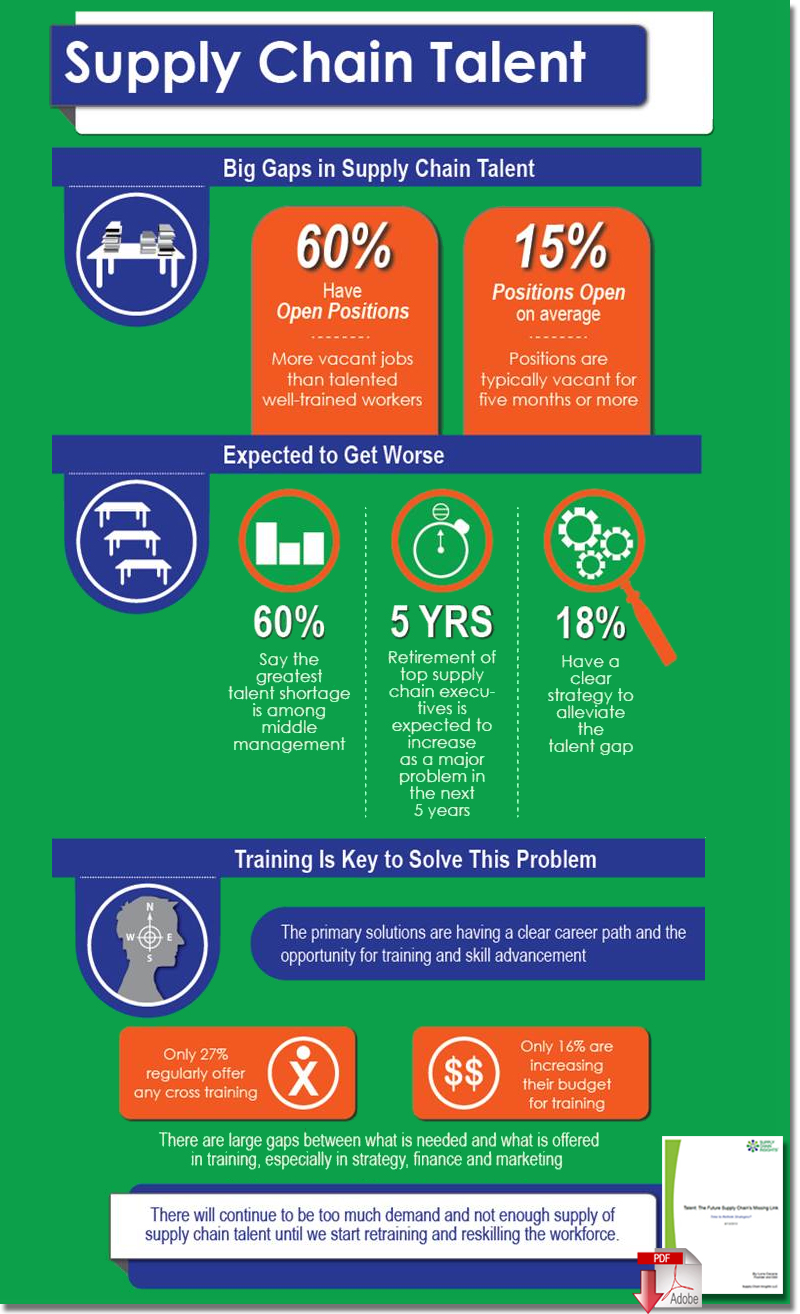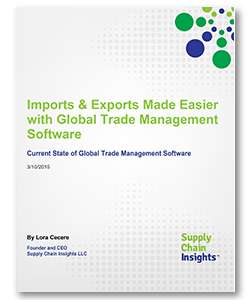Supply Chain Talent Is a Growing Gap for Leaders and the Impact Is Enormous
Five years ago talent was plentiful, companies could easily recruit for supply chain planners, and it was easier to recruit supply chain graduates - Not so today.
The biggest issues are in mid-management roles.
Let’s examine some of the facts from recent research.
Today, 60% of companies have open positions. Fifteen percent of the planning positions are open for an average time of five months.
An IBM surveys report that 51% of companies are seeing an increase in turnover of supply chain leaders.
Have I convinced you yet to be worried?
If so, let’s start working on an answer.
Let me give you the first clue. The answer is not recruiting more college recruits.
There is currently a 9:1 demand to supply ratio for supply chain graduates, and the skill level of new hires cannot stretch to fill the missing mid-management gaps.
It Starts with Leadership
Recently, I have been reviewing supply chain strategy documents for companies planning their 2014 strategies. I love talking to supply chain teams about their future. However, I am surprised that most companies do not see the gap in supply chain talent as a critical need to fill. The plans that they are sharing are not including the need to move aggressively on building supply chain talent.
There is just no understanding that the WORLD TODAY is not the WORLD of FIVE YEARS AGO. Five years ago talent was plentiful, companies could easily recruit for supply chain planners, and it was easier to recruit supply chain graduates. Not so today….
If only more companies had the view of Mike Corbo, current leader of the Colgate supply chain team. In my recent interview with Mike, he said he spent 30% of his time on team development. Notice how talent management is at the top of his mind:
“As an organization, we believe in building talent systems and hiring from within. I take my job as the leader of the 22,000 global members of the Colgate supply chain team seriously. I oversee succession planning for the supply chain organization. When it comes to talent management, it is a “single threaded needle.” While I am supported by an experienced and talented supply chain human resource team, managing talent is a large part of what I do. It takes time. It is 30% of what I do on a day-to-day basis. As a result, the reward and feedback systems for talent development are very consistent. The leader of the supply chain team has led succession planning for the last twenty-five years.
When people come to see me and ask for career advice, I tell them to do their current job VERY well. My advice is to “get real good at something and drive value today.” I believe that success is not always about moving up. I encourage members of the team to take enrichment opportunities in other areas of the company or other geographies; but I don’t want them to just spend time, I want them to contribute and learn. I believe that we should encourage people to move across the organization to get a greater understanding of the business. We do succession planning three times a year. I value cross-functional experiences.
I strongly believe that we cannot let regions operate as islands. We hire with the expectation that people will spend time in multiple regions and multiple functions.”
What Do We Do About It?
So, when companies agree that this is a problem, the next question is, ”What do we do about it?” Here are five steps that I think that supply chain leaders can take today:
- Recruit Heavily from Engineering Programs and Train New Hires on Supply Chain Concepts. Today many companies are competing for the same talent from supply chain programs in business schools. An untapped and more available talent pool is in the engineering schools. They can be trained to fill in the process mastery gaps. While they will need to be trained on the practical supply chain processes, they understand the concepts of process systems and they have the raw talent to build both technical and process mastery. In fact in some ways this may be helpful, because many supply chain programs are teaching old supply chain concepts, and very functional views, of the past.
- Focus on Making Your Teams Loyal Employees. Loyal and valued employees stay with organizations. Planning roles are at the bull’s eye of this “perfect storm.” Supply chain planning roles have the largest number of vacancies with the longest time to source. So, a perfect place to start is to make sure that your planning teams feel appreciated. Most planning teams have a low-level of satisfaction due to the fact that traditional processes reward the urgent, not the important. The research that we are doing strongly supports that companies that are good at planning are better able to balance costs, inventory and customer service.
- Cross Train. Enrich and improve cross-functional understandings through short-term assignments. Use the principles of co-op positions to for permanent employees to give them both job enrichment and cross-functional experiences. The largest gaps are in the areas of strategy and finance.
- Invest in Learning. In our recent studies, 1/3 of employees are asked to own their own training programs. And, we all know that training is usually the first thing that is cut in a downturn or a budgetary cycle. And, as my friend Marcia Conner points out so eloquently in our webinars, training is not the same as learning. Training is only one way to learn. Build stronger teams by embracing learning as a cultural value. One opportunity to do this is through the onboarding of new employees from other companies. One mistake I see companies make over and over again is believing that they have a clear understanding of best practices. Next week, I will teach a class where former P&G, Unilever and Dell employees have joined the same organization. They each believe that they understand “best practices”, but they are unaware of how different their understandings of processes like forecasting, network design, inventory management and sales and operations planning are. Each employee comes with a different paradigm. Use these understandings to forge better processes. Challenge why companies operate in certain ways and be sure to clear understanding of how these processes evolved based on constraints, cycles and market shifts. Help new employees build a bridge from prior experiences to the new environment early and encourage team discussions so that the entire team can to learn through the process.
- Don’t Take Mid-Management for Granted. Most organizations have programs for entry-level employees and “high-performers.” Most training plans take mid-management employees for granted. Don’t make this mistake. Build your own learning programs to help mid-management employees build process and technical mastery. While there are historic programs through APICS, CSCMP and other associations, leaders like Colgate, DuPont and Johnson & Johnson are upping the ante to build the next generation of thinking. They feel that these industry training programs have not kept pace with the needs of the industry. Partner with these industry leaders to take advantage of new ideas

Take the latest Supply Chain Talent Survey
For your participation in this survey, Lora Cecere, Supply Chain Insights Founder & CEO, will provide a free one hour consultative call with you and your organization to review the results and discuss your own talent strategies.
Take Your Supply Chain Talent Survey
Notice: Attend the “Supply Chain Talent: Is this a Missing Link?” Webinar
On this webinar, the results of the recent research study will be discussed by a panel of supply chain leaders.
Tuesday August 5, 2014 at 11:00 am ET | Register Now!













